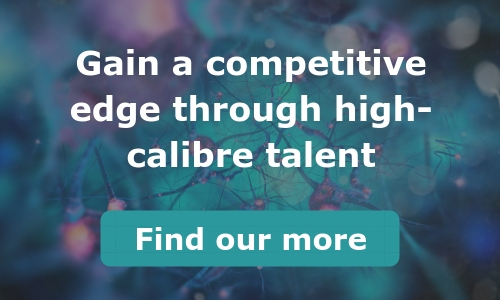It’s not always the candidates who make mistakes during the interview process. Hiring managers routinely do too.
And that’s not surprising. You see, hiring manager is a working title. Organisations don’t hire hiring managers. They hire executives, VP’s, senior managers – people who lead. If you’re in a position of authority and need to expand your team, you become a hiring manager. No experience needed.
But like anything, the more you practice, the better you become. Trouble is, for many hiring managers, the only way to gain experience is on the job. That means leading an interview for the first time and making an informed decision as to which candidate would be the best fit for the role and your team.
If you’re lucky, you might be offered some informal training or the chance to sit in on an interview for a similar position. You might even be asked to join an interview panel. But for many, their first experience of being a hiring manager is leading an interview and putting the candidate through their paces.
So it’s unsurprising that hiring managers do make mistakes. Poor hiring decision that can impact the company and applicant alike. The good news is that the mindset or condition that leads to these errors are usually easy to correct. Let’s explore the 5 worst hiring manager fails and how to avoid them.
1. Don’t define the role
Talk about tripping at the first hurdle. Despite hiring for their team, some hiring managers fail to undertake the necessary due diligence required to flesh-out an accurate job specification. The roles, responsibilities and objectives defined in the job specification are what candidates are ultimately judged against. It also informs Talent Aquisition and HR as to what the role entails and, crucially, what success looks like.
Some hiring managers schedule interviews without having the necessary understanding of what the role entails. Others understand the role but assume that the definition is universal when in reality a particular job title can mean different things in different life science industries.
The outcome? You interview candidates, make a job offer, onboard them, and then leave that person bewildered and disconcerted because what they expected to be doing and what the position entails are two different things. Regardless of how good your onboarding process, if the job specification is a poor representation of the role, your new hire will be a poor fit for the job, and you or your colleagues will have to waste valuable time bringing them up to speed and adjusting their expectations. Not a great first impression.
To help ensure that you hire the right candidate who knows exactly what is expected of them, take some preparatory steps:
- Create candidate personas that exemplify the ideal hire. Include details like job title, location, skills, experience, personal traits and goals. These personas, which are frequently used by sales and marketing teams to define their customer base, are effective guideposts and are increasingly being adopted in recruitment. Here is a great article on how to create a candidate persona.
- Create a search matrix that lists the 7-9 essential criteria for success in the role, starting with the must-have skills/attributes and ending with the nice-to-haves.
When you’ve completed the above, write a job description and submit it to someone in the team or someone who understands the position, to confirm that you’re along the right lines.
2. Fail to evaluate their hiring process
When a hiring manager doesn’t understand the internal hiring process at their life sciences company, or it is poorly defined, the outcome is both inefficient and counter-productive.
A slow time-to-hire results in a loss of productivity and revenue because vacant positions are taking longer to fill, which forces other employees to do many of the necessary tasks in the interim or the organisation abandoning or scaling down these processes in the short-term. What’s more, you run the risk of the best candidates accepting alternative offers because a life sciences company delayed too long. This loss of qualified and competitive applicants reduces the quality of the talent pool, leaving sub-par options and, potentially, a bad hire.
To avoid these lost opportunities, review your company’s hiring process for the following problems:
- Speed: OfficeVibe once reported that the highest-quality job seekers are off the market in an average of 10 days. How long does it take your organisation to extend a job offer?
- Ability to find talent: Are you receiving CVs from qualified candidates or applicants whose qualifications and experience are inconsistent with job postings?
- Data collection and decision making: Is your recruiting process data-driven, meaning that your hiring decisions are informed by facts?
- Process flow: How smooth is the hiring process? Are steps being regularly overlooked? Are delays common?
- Quality of past hire: Think about the employees you’ve hired in the last six months. Have they proven to be a good investment?
- Staff turnover: What is the organisations’ staff turnover rate? Higher rates are indicative of poor hiring decisions.
- ROI of new hires: Are you getting a return on your hiring investment when you hire a new person? How long does it take them to measure up to expectations?
A surprising number of life sciences organisations have not updated their hiring process in years. If this is the case with your organisation, it’s time to address all shortcomings. For example:
- If your organisation is too slow to hire, the best candidates will be gone. Make the process faster by eliminating unnecessary steps and giving decision makers deadlines.
- If you’re not seeing a good ROI, consider aptitude in addition to experience. A candidate with more experience might not do as good a job as someone with a greater natural aptitude.
- If you’ve hired applicants whose CVs were more impressive than their job performance, carry out more due diligence. Call references and confirm the skills/experience on their CV.
Once you define a process, stick to it. Resist the urge to revert to the flawed but familiar hiring steps when you encounter challenges. For your organisation to maintain an effective hiring process, there must be consistency. That way, each new hire is hired on the same merits and has a similar onboarding process. What’s more, the whole process can be optimised and improved.
RELATED: Increase quality-of-hire by partnering with a reputable boutique talent consultancy
3. Inadvertently increase time-to-hire
In a highly competitive marketplace, few things damage recruiting ROI more than a slow hiring process. Nonetheless, too many life sciences organisations inadvertently increase time-to-hire by:
- Demanding a certain number of candidates at shortlisting before the decision makers will assemble to make their decision. It’s a policy that leaves the earlier applicants in a holding pattern.
- Taking too long to or providing patchy responses to executive search firms, recruiters or Talent Aquisition when they have a candidate lined up.
- Agonising over making their final decision. If multiple parties are involved in the decision-making, trying to reach consensus causes further delay.
To increase your chances of engaging the right candidate, adopt the following approaches:
- Dispense with shortlisting quotas and review applicants on a case-by-case basis. Those with the necessary qualifications and experience should be scheduled for an interview ASAP.
- Stay in close contact with the executive search firm you use and respond quickly when they need further information or have found a likely candidate.
- Make your hiring and onboarding processes more robust by following the guidance in this blog. Doing so will also help you make informed hiring decisions.
4. Forget to prepare for the interview
When an interviewer doesn’t prepare their questions beforehand, they lose the ability to effectively evaluate candidates. They could waste valuable time asking too many questions whose answers are in plain site on the candidates’ CV, giving the impression that they never bothered to read it, or they don’t ask enough insightful questions, which conveys a lack of interest.
The outcome of this hiring manager mistake is a poor candidate experience and a negative impression of the company brand, which practically guarantees that they will refuse any offers.
Avoid this mistake by being thoroughly prepared for each interview. You can do this by:
- Researching the candidate. Study their CV and visit their LinkedIn profile. (The latter may provide additional insight into their experience, qualifications, and achievements).
- Preparing interview questions. Don’t just verifying what’s on the CV. Build your questions around the skills, experience and qualities essential for success in the role.
- Being ready to field questions. It’s easy to forget that you are being evaluated too. Be prepared for questions and verify how much information you can disclose in advance.
- Coordinating with other interviewers. If a panel is conducting the interviews, it is important to coordinate beforehand. Decide who will ask what questions and who will answer questions about a particular topic. For example, the department head can talk about the technology used to do the job while human resources can answer questions about pay.
- Making an agenda. When an interview is unstructured, the outcome is not as effective. With an agenda, the discussion will be more productive because important topics aren’t missed.
5. Don’t do due diligence
Anyone can look great on a CV. The problem is that people aren’t always truthful. A 2015 CareerBuilder survey of 2,500 hiring managers found that:
- 62% encountered applicants who embellished their capabilities or skills
- 54% have caught candidates exaggerating the scope of their responsibilities
- 25% have seen job seekers claim to have worked for companies where they were never employed.
Without due diligence, you could be deceived by a candidate who is less qualified for the job than they appear on paper, and decide to pursue them over other applicants. It’s only a matter of time before the truth is uncovered. How much time and resources are squandered will depend on the effectiveness of your candidate screening, interviewing and onboarding process.
To avoid such an outcome, stick to the recruitment process you defined in Point #2 which should include due diligence. A well-defined system and a little due diligence can help protect you from the most common hiring manager fails and secure candidates whose values align with the company mission, principles, and culture.
But at the end of the day, nothing beats experience. If you consider your hiring manager skills could do with a polish, ask to sit in on interviews with more seasoned hiring managers or take a seat in an interview panel. When combined with the pointers in this article, when it comes to taking the lead in the interview process for your next critical hire, you’ll be on top form.
For more hiring advice tailored to hiring managers in the life science industry…
- Read 8 Hiring Metrics To Focus On In Your Life Science Recruitment Strategy.
- View our talent solutions to see how we can help you gain a competitive edge through talent.
* Fraser Dove International is a talent consultancy operating exclusively across the life sciences industry. While our roots lie in executive search, we provide more than the traditional recruitment services. Uniquely placed within the market, we have been providing cutting-edge talent solutions and insight to organisations at all stages of their journey – from start-up to established leaders – since 2013.

 Estimated read time: 7 mins
Estimated read time: 7 mins Date posted:14/01/2019
Date posted:14/01/2019





